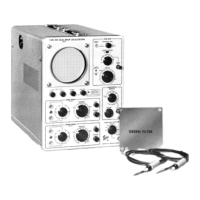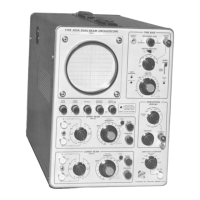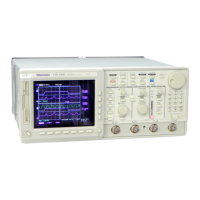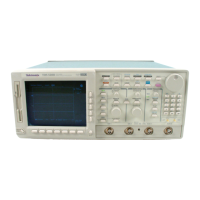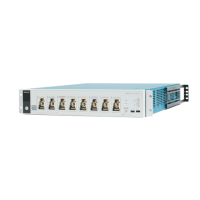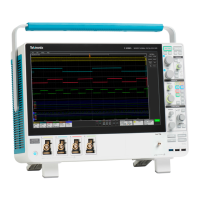Maintenance— Type 503
Replacement of the Cathode-Ray Tube
To remove the calhode-ray tube, first disconnect the
tube socket and all leads connected to the neck of the tube.
Remove the graticule cover, spacer washers, graticule, and
graticule light shield. Loosen the tube clamp at the base
of the CRT. Remove the CRT straight out through the front
panel |see Fig. 4-2).
Fig. 4*2. Removing the cathode-ray tube
When the new CRT is in place, tho leads can be properly
connected to tho neck of tho tube by following the color
code information provided on tho lubo shield. After replace
ment of the CRT, it may be necessary to calibrate certain
portions of the oscilloscope. Special attention should be
given to calibration of the sweep and tho vertical deflection
factor.
Replacement of Switches
Methods for removal of defective switches arc, for the
most part, obvious and only a normal amount of care is
required. Single wafers are normally not replaced on the
switches used in the Type 503. If one wafer is defective,
the entire switch should be replaced. Switches can be
ordered from Tektronix, cither wired or unwired, as desired.
Tube or Transistor Replacement
Care should be taken both in preventive and corrective
maintenance that tubes or transistors are not replaced unless
they are actually causing trouble. Often during trouble
shooting it will be necessary to remove lubes or transistors
from their sockets. It is important that these tubes or transis
tors be returned to their same sockets unless they are actually
defective; unnecessary switching of tubes or transistors will
often necessitate recalibration of the instrument. If tubes or
transistors do require replacement, it is recommended that
they be replaced by previously checked high-quality com
ponents.
Each checked pair of nuvistors used in the Type 503
Vertical and Horizontal Amplifiers' is mounted in a temper
ature-stabilizing assembly, and shock-mounted to minimize
microphonic effects. If replacement of these tubes is indi
cated, they should be replaced in pairs. While the removal
and replacement procedure is quite simple, reference to
Figs. 4-4 and 4-5 may aid in locating and replacing the
tubes. Use the following procedure:
1. W ith a short screwdriver, remove the mounting screw
and shockmounting stop bracket.
2. Grasp the temperature-stabilizing cover with the fingers
and pull toward the rear of the instrument, using a rocking
motion.
NOTE
When the cover lifts off, the nuvistors may remain
in their sockets, or may come o ff w ith the cover.
Care should be used in removing the tubes to avoid
bending the tube pins or the shield tabs.
« •- 4-3. Transistor heal-slabiliiing coven uted In instruments
serial numbered 6997 and taler.
3. Insert the replacement nuvistors in their sockets, orient
ing the tubes so that the wide shield tabs can be pushed
into the wide keyways (Fig. 4 4).
4. Replace the temperature-stabilizing cover, the shock
mounting stop bracket, and mounting screw.
At Type 503 Serial Numbers 6997 and later, transistors
Q354, G364, 0454, and Q464 are secured by heat-stabi
lizing covers (see Fig. 4-3). The covers are held in place by
plastic holders, and are removed by pulling straight out.
To replace, insert the holder lips in the mounting holes, and
push in until secure.
'A t Social Number 6997 and later, lube types 6DJ8 have been
replaced by nuvistor tubo typos 8393 in tho Vertical and Horizontal
Am plifier input stages.
©
4-2
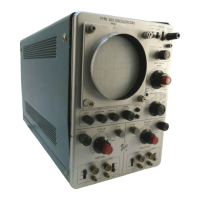
